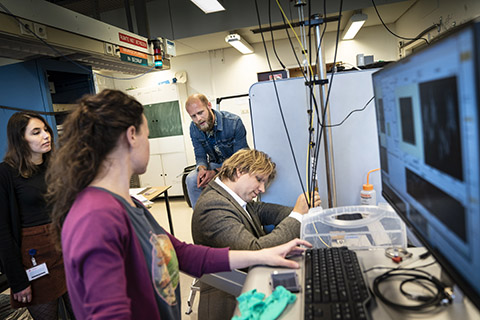
Learning from our thought process
Brain beats computer
Take a look at a picture of a cat. It doesn’t matter if you’re human or a supercomputer, we both recognise this as a cat. ‘But’, says Jasper van der Velde, the science coordinator for new research centre Cognigron, ‘[the computer] needs hundreds of thousands of watts to do so. A human brain only needs about twenty watts.’
Twenty watts could power a light bulb. In other words: when you compare computers to brains, brains win in many respects.
For one, brains are much better at pattern recognition than computers, because brains process information differently. That’s mainly because of the relationship between memory and information processing.
‘In traditional computers, those are divided across two separate components’, Van der Velde explains. ‘Before a computer can recognise an image as a cat, it needs to send information back and forth between its memory and its processor. That’s where the information is processed.’
Thousands of millions
But in our brains, the processor and memory are part of the same complex network of neurons and synapses. That means they can send signals to various locations in the brain simultaneously.
‘Because of that, our brains are much faster at comparing the image our eyes see to images of cats and dogs in our memory. Our brains also do this on a really small scale: a human skull contains thousands of millions of neuron connections that make this possible.’
The scientists at Cognigron want to try and learn from this. ‘It would be great if we could have computers with human characteristics’, says Van der Velde.
Computers simply aren’t efficient enough
But to do so, they need special materials that can process information, store it and then form networks. ‘We’re trying to create these materials – on a nano scale – that have some of our human characteristics. We hope to be able to combine these into neuromorphic chips; chips that work sort of like brains.’
Unused
The chips don’t have to mimic brains exactly. ‘They have to have the characteristics that make brains better than computers.’
Computers like this would be really useful to society. ‘We’re already collecting heaps of data’, Van der Velde explains. ‘But we use very little of it. Computers simply aren’t efficient enough to sift through everything. But if we can make computers that are better at pattern recognition and more efficient at processing data, that could be extremely useful.’
Take medical data, for example. ‘Computers like that could find similarities between groups of patients. It would enable doctors to make personalised treatment plans based on people’s personal characteristics’, says Van der Velde.
Computers that are better at pattern recognition will also be better at recognising images. ‘This could then be used to improve national security or help with making safer self-driving cars.’
Multidisciplinary
The RUG is not the only one who wants to create more efficient computers like this. ‘Some large corporations, like IBM and Intel, are working on it as well’, says Van der Velde. They even have working platforms based on brain power. The difference is that they’re still partially using classic technology. But it turns out this makes computers more efficient, too. ‘That shows that our idea to use different, potentially even more efficient materials, has potential.’
Cognigron’s strength is that we’re multidisciplinary
Other universities are working on similar projects. Twente started the project BRAINS with pretty much the same objective. ‘But Cognigron’s strength is that we’re purposefully being multidisciplinary. It’s what makes us unique.’
The Zernike Institute is involved in the project, bringing with it knowledge of materials science, physics, and chemistry. But the Bernoulli Institute is contributing maths, computer sciences, and artificial intelligence.
‘At artificial intelligence they have been working with neural networks for longer; computers that mimic the parallel data processing that brains do’, says Van der Velde. ‘They know what’s needed to improve those networks.’
Funding
The materials scientists can then look for the materials with the necessary characteristics, while the mathematicians can substantiate the techniques. ‘The scientists at Cognigron are also really good at developing different kinds of materials that learn tasks the way hardware does.’
Cognigron’s ambitions are grand. Thanks to a donation, they’ve been able to hire twelve professors and a number of PhD candidates. They currently have enough funding to continue their work for the next six years.
‘We want to take that time to demonstrate that new materials can in fact implement (on a nano scale) some of these great characteristics our brains have. And to prove that we can build complex systems to form the basis of a new type of computer.’

